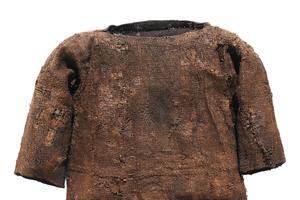Hair and teeth of “Egtved girl,” a young woman from the Bronze Age discovered in 1921, reveal the itinerary of his life.
Did you know? A portion of your anatomy can tell your story and enough to retrace your route. 2400 km traveled in fifteen months and one death to more than 800 km from his home region: the remains of a woman from the Bronze Age have spoken. His body was discovered in 1921 in the village of Egtved, Denmark. The body of the young woman of about 17 years lay in a hollow oak trunk, wrapped in cowhide since 1370 BC subsite has no bones, probably due to acidic water contained in oak coffin. But his hair, teeth, nails, skin and clothing remained very well preserved, and allowed to retrace its path in a study published Thursday in Scientific Reports (Nature) . This scientific survey conducted by an international team led for the first time, to also follow precisely the movements of one of our prehistoric ancestors.
A well-preserved remains
Thanks to recent advances in tracing techniques – biomolecular, biochemical, food and geochemical – researchers are able to map the mobility of a person during his life. Thus, although nicknamed “Egtved Girl”, the young woman would not native Danish village, contrary to what was long believed. In reaching this conclusion, the researchers analyzed the strontium content in the enamel of his teeth. He “works as a kind of GPS,” says Karin Margarita Frei National Museum of Denmark, co-author of the study. This chemical component that comes from what we ate when our teeth are formed to define the place of residence during childhood. “The analysis of the first molars of the young woman tells us she was born and lived his early years in a geologically different region of the Jutland peninsula in Denmark (where Egtved is),” says the researcher.

Top wool worn by the girl
Also, the wool top and skirt made of wool and beef strips of skin in which she was buried betray a production outside Denmark. “The sheep that provided wool grazed pastures in similar to those of the Black Forest,” notes the Danish researcher.
A native of Germany
The young woman would So native of this southwestern German region, over 800 km from the place of death. “I think this young German was given in marriage to a man from Jutland to forge an alliance between two families,” slips Kristian Kristiansen of Copenhagen University, co-author of the study. “We can not say exactly how many thousands of kilometers she has traveled not be sure that she lived in the Black Forest or a similar place, however, there is no doubt that she has moved on very long distances, “says Karin Margarita Frei. It is known that in the Bronze Age, the relations between Denmark and southern Germany were narrow, particularly because of the trade in amber and bronze.
If tooth enamel allows to reconstruct the early years of life, hair, here 23 cm long, give information about the last two years and nails over the last six months. In the case of the young woman, the most recent part of her hair (6 months of his life) and his nails indicate she made a very long journey before his death. “About 15 months before his death, the young woman was in the region of his birth. She then left in the Jutland region. After nine months spent there, she returns to her hometown to stay four to six months, and then left again for Egtved, a month before dying there, “says Karin Margarita Frei.
All the results, say the researchers, undertake to “rethink European mobility of the Bronze Age”: people were moving very quickly over long distances and for short periods of time.
No comments:
Post a Comment